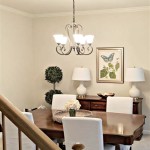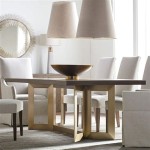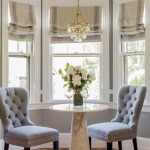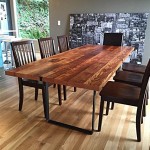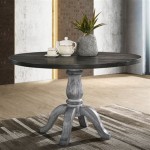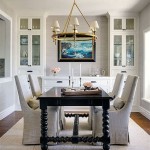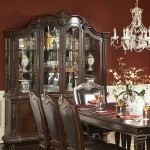Tiffany Style Dining Room Lights: Illuminating Elegance and Artistry
Tiffany style dining room lights represent a captivating blend of artistry and functionality, offering a distinctive aesthetic that elevates the ambiance of any dining space. Characterized by their vibrant stained glass designs, these lights draw inspiration from the iconic creations of Louis Comfort Tiffany, an American artist and designer renowned for his innovative use of glass. These fixtures are not merely sources of illumination; they are considered works of art, capable of transforming a dining room into a visually stunning environment.
The enduring appeal of Tiffany style dining room lights lies in their intricate designs and the warm, inviting glow they cast. These lights often feature elaborate patterns incorporating floral motifs, geometric shapes, and nature-inspired scenes. The use of multiple colors and textures in the stained glass creates a mesmerizing effect, adding depth and visual interest to the room. The diffused light, filtered through the colored glass, minimizes harsh glares and creates a soft, welcoming atmosphere ideal for meals and gatherings.
The Art of Stained Glass Construction
The creation of a Tiffany style dining room light is a meticulous process that requires skilled craftsmanship. The defining element is, of course, the stained glass. Authentic Tiffany lamps and fixtures were originally made with a proprietary method involving hand-rolled, opalescent glass. This glass was often streaked with different colors and textures, giving each piece a unique character. Contemporary Tiffany style lights, while often using different manufacturing techniques, still strive to replicate this effect using a variety of colored glass sheets. The process generally involves the following steps:
First, a design is created, and a pattern is meticulously drawn on paper, outlining the shapes and colors of the individual glass pieces. Each piece of glass is then carefully selected and cut according to the pattern, ensuring a precise fit. The edges of each glass piece are wrapped in thin copper foil, which allows them to be soldered together. The foil is then burnished to ensure a secure bond and a smooth surface. The individual glass pieces are assembled according to the design and soldered together, creating the complete lampshade or fixture. The soldered seams are often finished with an antique patina, which enhances the overall aesthetic and provides a durable protective layer.
The metal framework supporting the stained glass is also an important element of the design. It is typically made of bronze, brass, or other durable metals. The framework provides structural integrity and complements the stained glass design. In some cases, the metal framework is adorned with intricate details, further enhancing the artistic appeal of the light fixture. The combination of the stained glass and metal framework results in a visually stunning and structurally sound piece of art.
Selecting the Right Tiffany Style Dining Room Light
Choosing the right Tiffany style dining room light requires careful consideration of several factors, including the size of the room, the height of the ceiling, and the overall aesthetic of the dining space. A light that is too small may be insufficient to illuminate the room adequately, while a light that is too large may overwhelm the space. The height of the ceiling also plays a role in determining the appropriate length of the light fixture. For higher ceilings, a longer pendant or chandelier may be more suitable, while for lower ceilings, a flush-mount or semi-flush-mount fixture may be preferable.
The style of the Tiffany style dining room light should complement the overall aesthetic of the dining space. Consider the existing furniture, décor, and color scheme. For a traditional dining room, a Tiffany style light with floral motifs and warm colors may be appropriate. For a more contemporary dining room, a Tiffany style light with geometric patterns and cool colors may be a better choice. There are a variety of styles within the "Tiffany style" umbrella. Some lean toward Art Nouveau, featuring flowing lines and organic shapes. Others are more influenced by Art Deco, with geometric patterns and streamlined designs. The selection should harmonize with the existing design elements of the room.
When choosing a Tiffany style dining room light, it is also important to consider the light source. Traditional incandescent bulbs cast a warm, inviting glow, but they are less energy-efficient than other options. LED bulbs offer a brighter, more energy-efficient alternative, while still providing a warm and pleasant light. Be sure to select bulbs with a compatible wattage and color temperature to achieve the desired lighting effect. Dimmable bulbs offer even greater control over the lighting level, allowing you to adjust the ambiance to suit different occasions.
Maintaining Your Tiffany Style Dining Room Light
Proper care and maintenance are essential to preserving the beauty and longevity of a Tiffany style dining room light. The stained glass can accumulate dust and grime over time, which can dull its vibrancy. Regular cleaning is therefore recommended. The best way to clean stained glass is to use a soft, damp cloth. Avoid using harsh chemicals or abrasive cleaners, as these can damage the glass or the solder. Gently wipe the surface of the glass to remove dust and grime. For stubborn stains, use a mild soap and water solution. Be sure to dry the glass thoroughly after cleaning to prevent water spots.
The metal framework of the light fixture should also be cleaned regularly. Use a soft, dry cloth to dust the metal. For more thorough cleaning, use a metal polish specifically designed for the type of metal, such as bronze or brass. Follow the manufacturer's instructions carefully to avoid damaging the metal. Inspect the wiring and connections of the light fixture periodically to ensure that they are in good condition. If you notice any frayed wires or loose connections, consult a qualified electrician to have them repaired. Proper maintenance will ensure that your Tiffany style dining room light continues to illuminate your dining space for many years to come.
Additionally, consider placing your Tiffany style dining room light away from direct sunlight. Prolonged exposure to intense sunlight can cause the colors in the stained glass to fade over time. If your dining room receives a lot of direct sunlight, consider using window treatments to filter the light. Rotate the lampshade periodically to ensure even exposure to light. This will help prevent uneven fading and maintain the overall appearance of the light fixture. By taking these precautions, you can protect your Tiffany style dining room light from damage and ensure that it remains a beautiful and cherished piece of art for generations.

Tiffany Dining Room Lighting Lightsonline Com

Tiffany Style Ceiling Light Retro Dining Room Chandelier Stained Glass Lamp E26 Ebay

Vintage Tiffany Dragonfly Stained Glass 3 Light Chandelier Bulbsquare

Style Guide Tiffany Lighting And Decor Ideas Advice Lamps Plus

Tiffany Style Ceiling Lamp Retro Stained Glass Light Chandelier Fixture Ebay

11 13 Lights Dining Room Pendant Chandelier Tiffany Brass Down Lighting With Dome Stained Glass Shade 39 47 Wide Clearhalo

Customized Tiffany Billiard Dragonfly Lights Stained Glass Pendant Lamp Floor Made In Com

20 Tiffany Style Chandelier Peacock Stained Glass Pendant Lamp Hanging Light Shade

Cotoss Tiffany Pendant Light Fixtures Hanging Lamp Stained Glass Decor For Dining Living Room Kitchen Island Study Hallway

Pendant Lighting Tiffany Style 3 Light Art Hanging Kitchen Island Contemporary Chandelier Dining Room Vinluz

